|

|
|
|
|
about us |
|
|
see the beast |
|
|
our photo album |
|
|
explore tucson |
|
|
links |
|
|
email us |
|
|
sign our guest book |
|
|
home |
|
www.davidandcarol.com |
|
Our Magnificent Journey |
|
Chapter 14 |
|
2013 |
|
Argentina, Brazil and Peru |
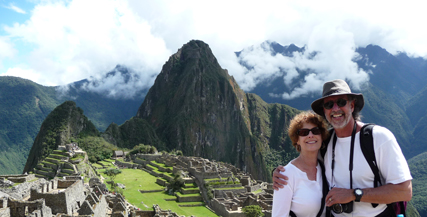
|
|||||
|
Click HERE to see our photos |
We slept well until 2 am when the wake-up call jarred us into consciousness. After quick showers we gathered our belongings, checked out of our terrific hotel, the Mar Ipanema, and took a taxi 30 minutes to the International Airport for our 6 am TACA flight to Lima, Peru. |
There was some craziness/confusion at the Rio airport but we made it through security finally and sat at Gate 10 reminiscing about the trip so far. We will definitely miss the magic of Rio. |
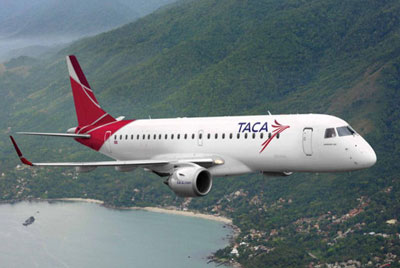 |
Our flight departed on schedule and we headed northwest for a five-and-a-half hour ride across the entire continent of South America, from Rio de Janeiro, Brazil on the Atlantic Ocean, to Lima, Peru on the Pacific Ocean. The cross-continent flight is roughly equivalent to flying from New York City to Los Angeles. |
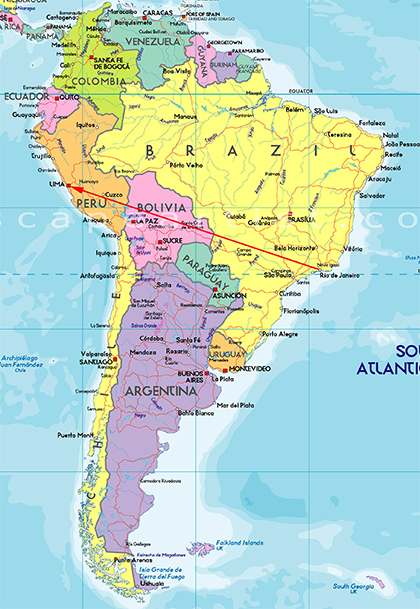 |
About two hours from Lima, the snow-capped peaks of the Andes began popping up. Soon, far below, the carpet of giants stretched from horizon to horizon. As we approached Lima we turned due west and as we approached the coast and passed out over the Pacific, the Andes abruptly gave way to a sandy plain that hugged the Pacific as far as the eye could see north and south. |
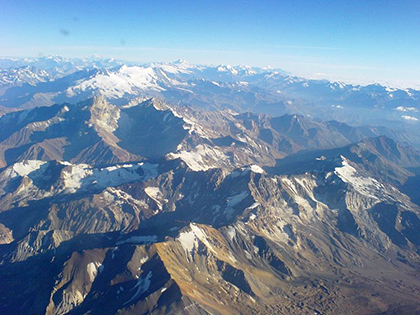 |
Soon we landed in Lima, rested and ate a delicious airport lunch of rice with vegetables and chicolitas (large kernels of corn in a tasty yellow sauce accompanied by a hard-boiled egg.) Not bad for airport food. |
After a two-hour layover we boarded a 1-hour LAN flight to two-mile-high Cusco. As we approached Cusco, we noticed that although the plane was at altitude, the snow-capped peaks of the Andes were high above us. |
Waiting for us outside of the Cusco airport was amicable Jesus, who drove us ten minutes through the quaint and bustling town to our hotel, the Tierra Viva Cusco Plaza. |
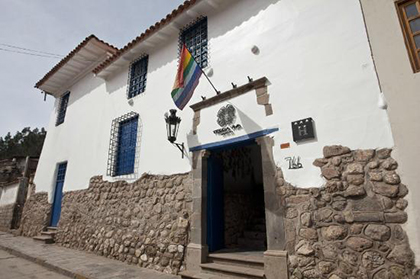 |
We settled in and drank several cups of the hot coca-leaf tea that the concierge suggested in order to help acclimate to this high altitude. My seatmate on this morning’s flight from Rio to Lima, who is himself a resident of Lima, suggested that we check into the hotel, drink lots of the tea, chew the coca leaves that are omnipresent, eat nothing at all tonight, and just sit on one of the benches in the large square, all with the intent of acclimating quickly in order to avoid the dreaded altitude sickness. Sounds like a good plan to us!! |
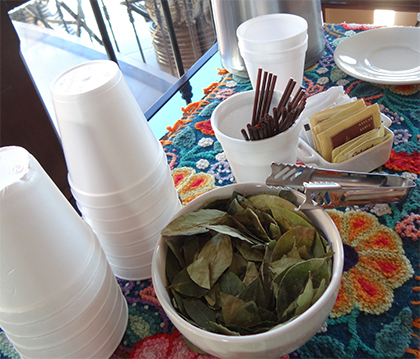 |
Cusco, often spelled Cuzco, is a city in southeastern Peru, near the Urubamba Valley of the Andes mountain range. It is the capital of the Cusco Region as well as the Cuzco Province. In 2007, the city had a population of 358,935. Located on the eastern end of the Knot of Cuzco, its elevation is around 12,000 ft. |
| Cusco was the site of the historic capital of the Inca Empire and was declared a World Heritage Site in 1983 by UNESCO. It is a major tourist destination and receives almost 2 million visitors a year. It is designated as the Historical Capital of Peru by the Constitution of Peru. |
| The indigenous name of this city is Qusqu. Although it was used in Quechua, its origin has been found in the Aymara language. The word itself originated in the phrase qusqu wanka ('Rock of the owl'), attending to an ancient myth. According to this legend, the warrior Ayar Awqa (Ayar Auca) got wings and flew to the site of the future city and transformed into a rock to mark the possession of the land by his ayllu ('lineage'). |
| The first Spaniards arrived in the city on 15 November 1533. Francisco Pizarro officially arrived in Cusco on 23 March 1534, renaming it the "Very noble and great city of Cuzco". The many buildings constructed after the Spanish invasion have a mixture of Spanish influence with Inca indigenous architecture, including the Santa Clara and San Blas neighborhoods. The Spanish destroyed many Inca buildings, temples and palaces. They used the remaining walls as bases for the construction of a new city. |
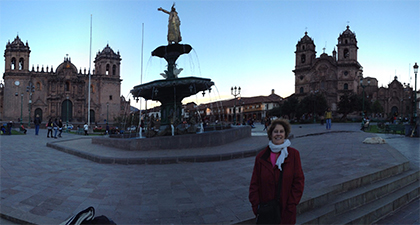 |
We sat in the Plaza de Armas and enjoyed its mellow vibe as the scent of many Eucalyptus wood fires wafted through the cool air. As the sun set, the temperature noticeably dropped very quickly and we walked slowly back to the hotel to grab our jackets. Even though our hotel is less than 100 yards from the square, the thinness of the oxygen at this altitude winded us every ten steps and we had to repeatedly stop to catch our breaths. |
We donned our jackets, downed some more cups of coca-leaf tea, then went back to the square to enjoy the calm evening vibe. |
There are many stray dogs here but they seem to be well-fed and very friendly. One in particular took a liking to me and came up to me repeatedly during our many visits to the Square. We love this place! |
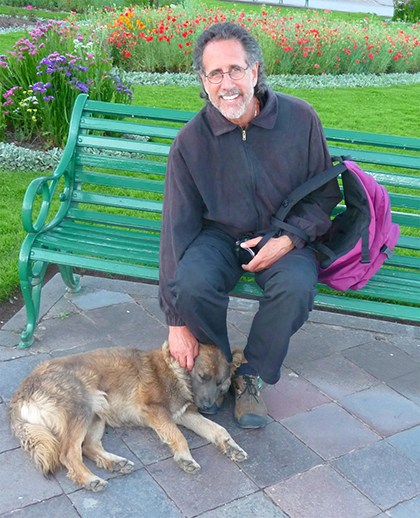 |
At 6 pm we came upon El Meson restaurant and sat at large windows upstairs sipping delicious warm quinoa soup for Carol and tomato soup for me, along with Inca Kola (highly caffeinated, which helps to acclimate to the altitude.) |
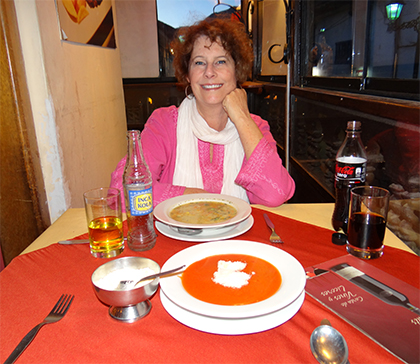 |
After dinner we strolled around the square window shopping the many alpaca and arts and craft stalls. |
At this point we’ve been up since 2 am so we huffed and puffed our way back to the hotel. The hike up the hill took its toll on Carol and she needed oxygen, which fortunately all hotels keep on hand. She’s a real trooper though, and she’ll tough it out. Hopefully she’ll soon feel her normal pink (instead of blue “Smurf”) self. |
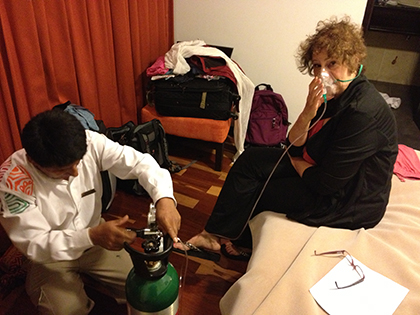 |
Totally exhausted, by 9 pm we were sound asleep two miles above sea level. |
| Previous Day |
copyright 1998 / david
and carol lehrman / all rights reserved |
email david@davidandcarol.com |